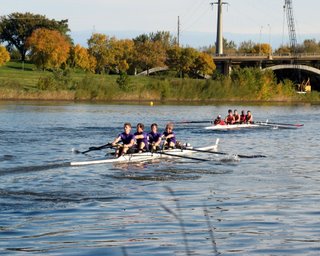 This morning, I went to the Birdland Marina near Prospect Park in Des Moines to see some of the early events in the Head of the Des Moines Regatta. Looking for information about the regatta and rowing in general, I found the following:
This morning, I went to the Birdland Marina near Prospect Park in Des Moines to see some of the early events in the Head of the Des Moines Regatta. Looking for information about the regatta and rowing in general, I found the following:This event has recently been named to be a premier regatta by the United States Rowing Association's Judge Referee Corps.Not bad!
When I arrived, I saw one- and four-person shells (boats) making their way up and down the river on a beautiful autumn morning. Since I was the only spectator at my location, I got the hint that there were probably better locations and moved down to the Botanical Center area, one end of the course.
At my new location, I saw a handful of the four-man shells bobbing quietly on the river with several more coming downstream. A power boat was anchored in the middle of the river with a woman with a bullhorn giving instructions for the initial line-up; I was pretty sure I'd found the starting area. Amateur radio service and flag man provided simultaneous signaling to the shell crews and to officials at the finish line. As I listened to the radioman call for each team's time to begin, I heard that teams had come from Kansas, Minnesota, Nebraska, and other places I didn't recognize as well then nor remember now. It must be a pretty popular event.
I climbed down to the waters edge, got a few photos, and listened to the directions being given from the shore, the powerboat, and the shell leaders or coxswains. It was an active and interesting place for someone not familiar with the sport. I moved to another location about one hundred yards upstream to see them pass at "full pressure," a term I overheard and figure must mean full effort.
As the women's four-person shell set out, shells crewed by eight women were arriving. They were very fast when they got moving ... and they got moving quickly! It was fun to listen to the different approaches taken by the coxswains. Some were gruff, some were even in tone. Some gave lots of information while one simply said "Catch!" to synchronize her crew.
 I was also surprised to see that the coxswains can either be seated in the stern or lying in the bow giving commands to the rowers. When they lie in the bow, you generally just see their head and shoulders. I saw both approaches use headsets and speaker systems to communicate with their crew. In the image to the right, there are three things to notice:
I was also surprised to see that the coxswains can either be seated in the stern or lying in the bow giving commands to the rowers. When they lie in the bow, you generally just see their head and shoulders. I saw both approaches use headsets and speaker systems to communicate with their crew. In the image to the right, there are three things to notice:
- The shell in the background is one with an eight-person crew.
- The shell at the middle left has the coxswain in the bow.
- The shell in the foreground has the coxswain in the back and you can see the headset.
I also learned that this would probably be called a Head Race:
Fall races, typically rowing upriver over a winding course covering several miles. Times for the races are based on start finish times, not head-to-head racing.
Now you all know at least as much as I do about this sport. It was impressive and appealing to watch... even if I was the ONLY spectator I saw!






No comments:
Post a Comment